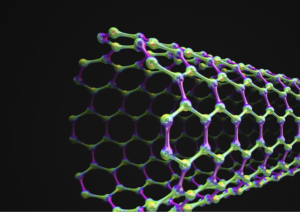By Bryce Keeler, President
 Carbon Nanotubes (CNTs) are cylindrical structures of pure carbon with walls a single atom thick and, despite being 10,000 times smaller than human hair, CNTs have many unique properties, including:
Carbon Nanotubes (CNTs) are cylindrical structures of pure carbon with walls a single atom thick and, despite being 10,000 times smaller than human hair, CNTs have many unique properties, including:
• Harder than a diamond
• 100 times stronger than steel
• 1,000 times the current capacity of copper.
When CNTs and their properties were discovered in 1991, and considerations made for how materials would react with increasing number of these miracle tubes inside them, they were hailed as the next material science revolution that would change materials and the products they made forever. The unimaginable would become possible: paper-thin antiballistic vests, super-light airframes, and even space elevators would all become feasible with the incredible properties of CNTs.
However, even though CNTs really do have these and many more amazing properties, there were no sensational, CNT-loaded materials released in 1991 — or since. And there is a very good reason for that.
The main challenge with CNTs is when they are manufactured, they agglomerate (or clump) into balls of millions and sometimes billions of tubes. And despite there being so many CNTs in these clumps, this agglomeration proves their downfall. Clumped CNTs not only prevent their unique properties from being transferred into a receiving system, but they also end up being detrimental to the receiving system.
This “many is great, except when clumped” paradox makes more sense when we consider a similar application in concrete. Concrete on its own is a strong material, but when you add rebar, the tensile strength is increased significantly. Rebar-reinforced concrete is far more capable of resisting cracking and breaking under tension. However, if you took that rebar and clumped it into an agglomerated mass before putting it into the concrete, it would not help the concrete whatsoever. Instead, it would be detrimental.
And that is what went wrong with CNTs. In their natural state, CNTs agglomerate. Adding agglomerated CNTs proved detrimental to materials — just as a clump of rebar would prove detrimental to concrete. Agglomerated CNTs are what prevented the launch of CNT-loaded lines of enhanced products in the 90s and since.
CNT Solution = dCNTs
If clumped CNTs are the problem, what is the solution?
To avoid introducing detriments into materials from the clumped nature of CNTs, CNTs must be made discrete. Obtaining discrete CNTs requires nano engineering – changing material properties at the nano level.
Mechnano’s proprietary technology detangles and separates CNTs, then disperses them throughout additive manufacturing (AM) materials without re-clumping.
The resulting discrete, functionalized, and dispersed CNTs are called dCNTs and can be tailored to the specific requirements of the selected system to deliver previously unattainable performance. Mechnano can functionalize dCNTs for a single property improvement in a material or several.
Mechnano has demonstrated impressive results from numerous AM material development projects, including:
• 200% increase in toughness
• 850% increase in tear resistance
• Improved part longevit
• Acquired ESD properties
dCNTs outperform standard CNTs significantly in a variety of materials. Standard CNTs agglomerate (bundle), and in this clumped state, do not transfer their beneficial properties to the receiving system.
Efforts to break up the bundles have resulted in “ropes.” And although their shape may seem more beneficial than an agglomerated ball, these ropes are still comprised of hundreds of thousands of tubes. Ropes may achieve a broad ESD-rating in AM parts, but they are not fully dispersed into the system. This means the polymer will have white space where there is only insulating polymer vs. CNTs to dissipate static, resulting in ESD failure. Alternatively, if an electrical source hits a rope directly, this mass of CNTs will act as a “lightning rod,” leading to conductive vs. dissipative behavior and frequently pock the part’s surface. Since CNTs don’t transfer their mechanical properties when clumped — even if that clump is a rope — these ropes will be a mechanical failure introduction point in the printed part as well.
To obtain the benefit of CNTs, they must be discrete and fully dispersed into the polymer. Once this is achieved, parts will have no insulating white space to block static dissipation, no ropes to act as lighting rods, and no CNT bundles to introduce mechanical failures.
dCNTs ensure totally discrete and dispersed characteristics to provide the exact ESD rating selected for the polymer, while achieving impressive mechanical improvements (vs. degradation) to the part. This is all achieved with 20X fewer tubes than normal CNTs to achieve an ESD-capable part.
Whereas ropes and bundled CNTs exhibit performance loss in critical areas such as tensile strength and impact resistance, dCNTs demonstrate improvements. Mechanical tests have shown that simply replacing normal CNTs with dCNTs in polymer systems doubles mechanical performance.
dCNTs Provide Great Improvements
Common practice in material development is to find ways to push the boundaries of materials’ capabilities. This is achieved by combining chemistries, increasing molecular weight of species, adding bare nanomaterials, or adding fibers for unidirectional strength.
Mechnano’s approach to material development differs from this common practice. By using nano engineering to purify, oxidize, and functionalize selected carbon nanotubes to match the thermodynamic, chemical, and other characteristics of the base polymer system, Mechnano can change the nanomaterial at the molecular level to meet property improvement requirements in all dimensions.
The results are new, unique, and exceptional discrete carbon nanotubes functionalized to exponentially improve AM material properties. With dCNTs, Mechnano introduces new material properties into existing materials in previously unthinkable ways.
Examples of actual projects and the performance gains achieved include the following:
• 60% improvement in Flexural Modulus in extruded polycarbonate thermoplastic
• 3X impact resistance increase in a VAT photopolymerized rigid thermoset
• 100X tear resistance gains in a jetted elastomeric resin
• Part longevity enhancement observed
• Static dissipative and conductive properties introduced into insulative polymers
• Consistent volume and surface resistivity across entire part, tunable to desired spec
dCNTs are unique in that they can bring a desired property into a system, while increasing several other key properties vs. degrading them. A great example of this is Formula1 — the first ESD VAT Photopolymer using dCNTs. This material was functionalized specifically for static dissipative performance — achieving an outstanding 10^7 Ohm in its volumetric and surface resistivity across entire parts regardless of size.
Despite the nano engineering focus on ESD, other important gains were achieved over the base polymer, including:
• Impact +60%
• Young’s Modulus +30%
• Yield strength +20%
• UTS +8%
• ESD obtained
• No carbon sloughing
Is this multiplicity of benefits normal? Certainly not until Mechnano solved the CNT problem. Prior, material developers commonly turned to carbon black (CB) to use as filler to obtain ESD properties in a material. But the high loading requirement of CB for ESD resulted in a part with lower tensile, young’s modulus, impact resistance, yield strength, as well as carbon sloughing.
dCNTs are proving the original hype of the 90s was warranted. CNTs just needed to be discrete to offer up all those promised gains. dCNTs are making those promises a reality.
Company Overview
Mechnano is the company first to fabricate parts with dCNTs using vat photopolymerization systems. The company’s dCNT allows for exponential improvements of nearly all types of AM materials with properties that were previously thought impossible. dCNTs enable improvements in areas such as static dissipation, impact, tear resistance, and tensile. Headquartered in Arizona, this US company is backed by over a decade of research and development and protected by over 120 issued and pending patents.
Mechnano produces masterbatches using dCNTs, which allow formulators to create high-performance resins. Materials made with Mechnano’s E35A masterbatch have excellent mechanical properties and have an ESD of 107Ω, which is the ideal static dissipation range for parts that come in contact with sensitive electronics.
Mechnano also produces two white-labeled ESD rigid resins, Formula1 (with 91°C HDT rating) and C-Lite (a partner resin with Tethon3D that has a 250°C HDT rating), in addition to the E35A masterbatch. Vat Photopolymerization OEMs can use E35A to make their own ESD resins to match the requirements of their customers, as well as white-label and sell Formula1 and C-Lite to their customers.
The following table is taken from the Technical Datasheet (TDS) of Formula1 — a black, rigid resin that yields a smooth surface finish — as an illustration of the strong mechanical performance ESD resins with dCNTs may achieve. Despite being functionalized specifically as an ESD resin, the addition of dCNTs improved mechanical properties compared to reference formula.
OEM clients desiring to save time and money over machined ESD alternatives will benefit greatly from dCNT-based solutions, which produce strong, fine-featured ESD parts.
Whether you are ready to buy masterbatches or resins enhanced with Mechnano’s dCNTs, or if you have questions about other dCNT applications, contact Mechnano today at mechnano.com.

